by Tom Gaylord
Writing as B.B. Pelletier
This report covers:
- Pro-Sport trigger
- Based on the Rekord
- Set trigger
- Rekord is not set
- What is dangerous?
- Hair trigger
- Slippage
- Fingers with neuropathy
- Cold fingers
- So what?
- TX trigger
- Mach II trigger
- Pro-Sport trigger adjustment
- Stage one
- Stage two
- But wait…
- Summary
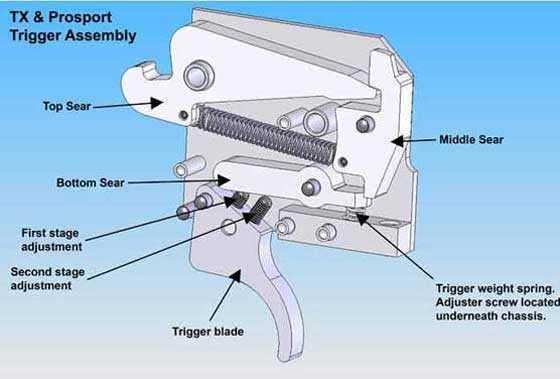
Air Arms Pro-Sport and TX200 trigger. Graphic from Air Arms.
Pro-Sport trigger
Today I show you the trigger of the Air Arms Pro-Sport rifle that I’m testing. I said in Part 2 that I was going to show how to adjust it in Part 3, and then I breezed right past that and shot groups instead. The reason I did is because this trigger was adjusted perfectly as the rifle came to me from the factory. Stage two breaks at 14.8 ounces. It’s far too light for sporting use but perfect for shooting from a bench in a warm environment.
I normally don’t take the time to write about adjusting triggers for you, though in the recent past there have been several exceptions. The Pro-Sport trigger, which is identical to the TX200 Mark III trigger, needs to be another exception, because it is one of the finest sporting air rifle triggers on the market.
Based on the Rekord
To understand the Pro-Sport trigger we first need to understand the Rekord trigger that preceded it by several decades. The Rekord is a multi-lever trigger that is very closely related to a set trigger that can release in fractions of an ounce. But a Rekord is not a set trigger.
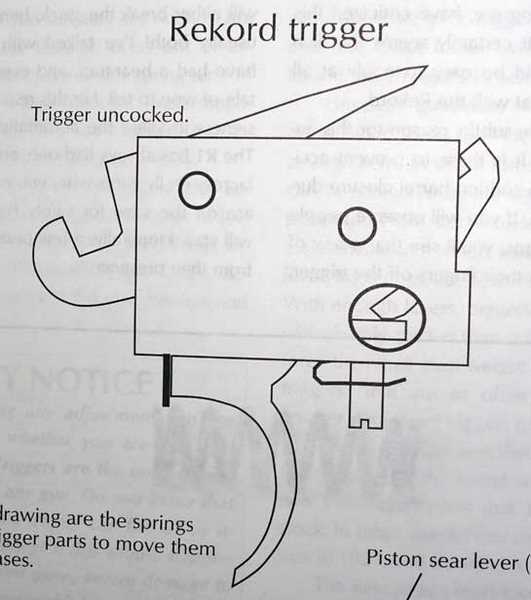
This is the Rekord trigger. Yes, I photographed it from my Beeman R1 book, because I apparently no longer have the original artwork.
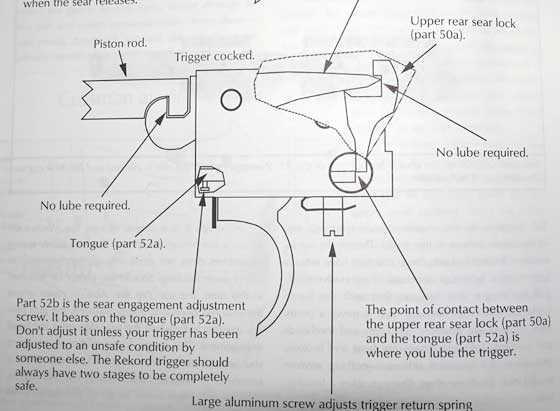
Here is a look inside the sheetmetal trigger box that holds the Rekord trigger parts. Also taken from my R1 book.
Set trigger
A set trigger is “set” (armed would be another good word) by moving its parts into position so that the slightest pressure will make it operate. It can be a single trigger blade that is pushed into the set position, in which case it is called a single-set trigger. Or, there can be a second trigger whose only job is to pull all the trigger parts into position — “setting” or arming the real trigger. When there are two trigger blades it is called a double-set trigger.
Rekord is not set
But the Rekord trigger is never set. It is a proper two-stage sporting trigger. It should always have a first stage that is light and stops when resistance is encountered! That resistance is the effort needed to pull the second stage to the release point, firing the airgun. That second-stage resistance can be adjusted very light — so light, in fact, that it becomes dangerous.
What is dangerous?
If a gun fires because the shooter has his finger in the triggerguard and it touches the trigger blade unintentionally — that is not an accident. That is a stupident! I have done it. Maybe you have done it, and I know stories that I’m sworn not to reveal about people nearly everyone knows who have done it. That is not an accident and it is not the trigger’s fault.
Hair trigger
What IS the trigger’s fault is when the gun fires because the weight of the trigger blade alone causes it to move and the sear to release. Think it’s impossible? Think again. There are set triggers that can be set that light and they fire when the muzzle of the gun is elevated and the trigger pivots back on its pin because of gravity. I have seen guns with triggers set that light. Those are called hair triggers because supposedly the force of one human hair against them will set them off. But many people call a one-pound trigger a hair trigger because, to them, it’s so light that it fires before they are ready.
Slippage
Then there are triggers that fire all by themselves because their sear angles are not correct. All it takes to fire these triggers is to reduce the friction and give the trigger a small push. A 100-pound coiled mainspring pushing against a piston (when a spring-piston rifle is cocked) can provide such a push. These triggers may function perfectly for many years and then fail when they are lubricated with a high-tech lubricant like moly that drops their friction below the point needed to hold them. I have a hole in the ceiling of my office from a BSF S55N that fired unexpectedly from this problem. A slipping trigger is a well-known fault of BSF triggers.
Fingers with neuropathy
Maybe you have neuropathy in your fingers and don’t recognize it. It comes in many forms — one of which is you loose sensitivity in your hands, including your trigger finger. You know that it’s getting harder to pick up postage stamps and coins, but it hasn’t dawned on you that a trigger can also be a problem. You can’t feel the blade until you put 5 pounds of force on it, by which time the gun has already fired.
Cold fingers
When you are out hunting in cold weather your fingers loose their sensitivity, and a one-pound trigger becomes a hair trigger. Cold weather calls for 5-pound triggers, which is the military standard for nearly every nation on the planet.
So what?
The Rekord trigger was designed to be a nearly foolproof two-stage trigger that can be adjusted to suit your preferences, within reason. And, it’s the “within reason” that catches many airgunners. For instance, I just read on one forum where Rekord trigger adjustment screw 52B — the one Beeman has recommended for decades that you never adjust — is laughed at! This forum calls that adjustment a fake. Well, that adjustment determines how much sear engagement stage TWO will have in the trigger. If someone comes along not knowing the consequences and wants an 8-ounce single-stage trigger and they adjust screw 52B to get it, they have just adjusted out all the “proof” in “foolproof,” and what does that leave?
TX trigger
But this report is about the trigger in a Pro-Sport. Well — until you understand how a Rekord trigger works you will have a hard time understanding the more sensitive trigger found in the Pro-Sport.
Mach II trigger
Many rears ago I owned a Mach II trigger (a Rekord trigger replacement) that was custom made by Ivan Hancock. It looked deceptively simple, yet it could be adjusted to a razor’s edge. I no longer have that trigger but let me show you what it looked like — again from my R1 book. Before you get all goose-pimply, please know that the Mach II trigger sold for around $250 in the mid 1990s. It would be a $400+ trigger today.
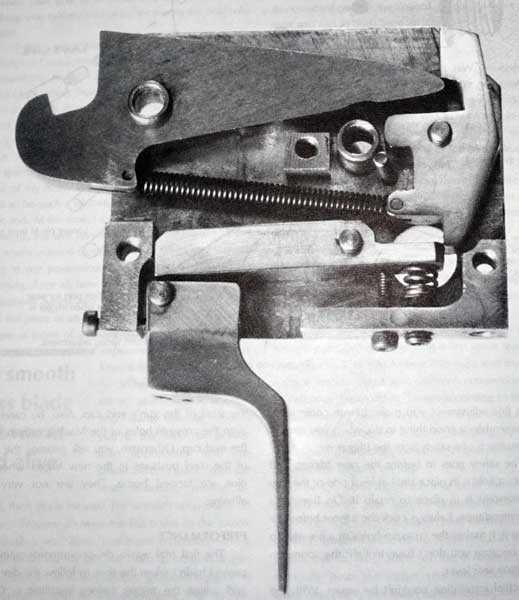
The Mach II trigger exposed. It looks almost identical to the Air Arms trigger graphic above. Two screws in the trigger blade (their holes can barely be seen in this photo) put pressure on the part that Air Arms calls the bottom sear when the trigger is pulled. Notice how close these screws are in this blade.
I showed you the inside of the Mach II trigger because it is nearly identical to the Air Arms trigger except it’s “box” is made of brass and has a brass plate that can be removed to look inside. The Air Arms trigger is inside a sheetmetal box that also opens like this, but I used the Mach II trigger photo that I already had. After shooting the Pro-Sport for record I just don’t want to spoil that gorgeous trigger pull that it came with!
Pro-Sport trigger adjustment
For this discussion we will concentrate on those two adjustment screws that pass through the trigger blade. I hope you understand how a lever works, because these two screws rely heavily on that principal.
The Record trigger doesn’t have these screws. It depends on the shape of the trigger blade (two raised humps) to accomplish the same thing as these two screws, but its shape cannot be adjusted. So people adjust that trigger all that they can, which turns out to be screw 52B. The Air Arms trigger is therefore much more adjustable, and to a finer degree.
Stage one
Stage one is adjusted by the front screw which is also the shortest one. It presses on the bottom sear (the lever) at a point farthest from the fulcrum. That means it moves farther and applies more energy to the lever, but all it is pushing against is the trigger weight spring, so the effort is miniscule. The further in that screw is adjusted the shorter stage one becomes. The trigger blade stops when it encounters more effort. Now, where would that be?
Stage two
The trigger stops when the stage two screw touches the bottom sear. It is closer to the fulcrum and therefore applies less force because its mechanical advantage is less than the stage one adjustment screw. But the stage one screw is still pushing against the bottom sear, too, so the effort to move the trigger blade increases by an amount that can be felt. This point is felt as the stage two stop just before the gun fires.
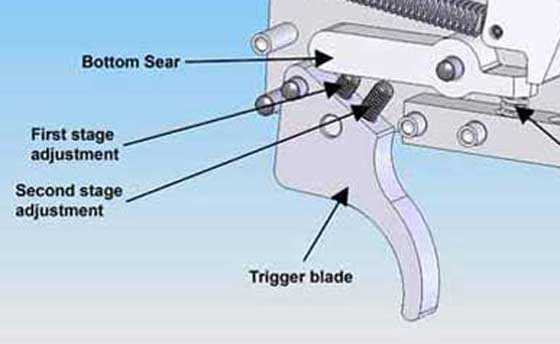
The trigger blade pushes up on the lower sear with the stage one screw until the stage two screw is encountered. This is the stage two stop. Then it pushes up with both screws.
If you understand what I have explained so far you can see why the Air Arms trigger is capable of so much finer adjustment than a Rekord. Both stage one and stage two screws act in unison to control how this trigger responds.
But wait…
Yes, there is more but it’s only found on the Mach II trigger. It’s the other screw that passes through the trigger floorplate next to the pull weight spring. That is a positive trigger stop. If you look at the Air Arms trigger you see there isn’t much room to put in a stop screw like that. So they didn’t. This is the one area in which the two triggers differ.
Summary
What I have shown you today are the fine adjustments that make the Air Arms Pro-Sport and TX200 Mark III triggers the finest adjustable triggers in the sporting spring gun world today. I have told you where the trigger on my rifle is set, but I have avoided messing with it because it is so right on as it is.
So what comes next? I have received a 12 foot-pound tuneup kit from Vortek, and I plan to install it next, then test the gun for velocity and accuracy again. And I hope to mount the Meopta scope for that test. After that, who knows?

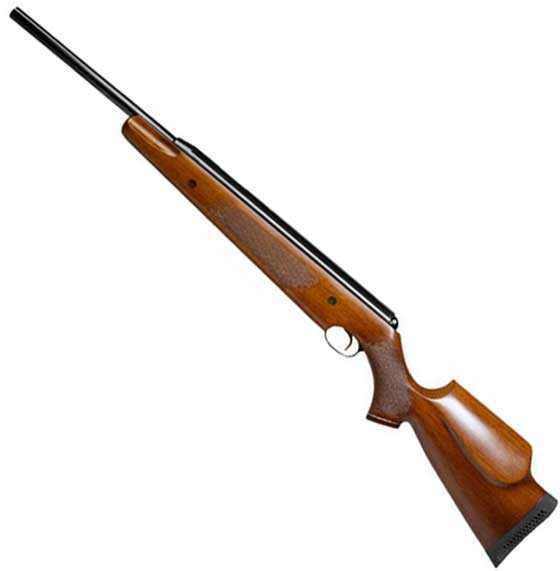
V-mach trigger units are less than 250$ these days due to currency fluctuation.
Edw-
I assume you are talking about this trigger? https://www.krale.shop/en/trigger-unit-v-mach-weihrauch.html
B.B.
Is this the trigger you are talking about?
If Air Arms and Weihrauch can make good triggers, why can’t every other airgun maker?
Good report on a nice rifle.
-Y
Yogi
That looks like a copy of the Rekord — not the Mach II.
B.B.
Edw,
Really? That is surprising! I didn’t know they were even being made any longer.
Thank you,
B.B.
B.B.,
Wow! I’m glad that I bother to research and gather opinions before taking a screwdriver to my triggers.
Siraniko
As i think i have mentioned before i do have neuropathy though i am fortunate in that with medication the worst of the pain is held at bay the numbness doesn’t keep me from feeling in the classic sense though keep in mind the condition and level of impairment is an individual experience and to some degree progressive. I feel triggers and as i have stated and perhaps more than i should. The subject of how sensitive a trigger should be for sporting use a solution of sorts exists in firearms and specifically i am speaking of the Savage accutrigger. For those who have not used one a blade is depressed through a channel in the trigger a mrchanism that prevents the trigger from firing until the blade is pushed through it allowing for a light trigger to be used in a safe manner and though they can be tuned mine is just broken in. So yes it is a different trigger and though i do not know of such a system for air rifles i am sure one could and should be made.
I am well aware that this is an overly simplistic coverage of the concept. I wish i had the opportunity to use and examine every sort of trigger. Unfortunately i do not own an Air Arms springer. I have questions that will have to come another time as i have a bad migraine starting.
Conceptually, I find that the easiest way to explain the Accutrigger is that from the shooter’s perspective, it’s almost like the Glock-style trigger on pistols, although obviously the method of operation is a bit different since the pistols are (sorta/kinda) double-action while the rifles are obviously not.
BB,
Sweet. I do so enjoy seeing behind the curtain. That Vortek kit should make that one fine shooter. You may leave her where she is after that.
I really need to bring my Tomahawk down some.
If the trigger pull weight is adjusted too low, the safety will not set reliably in a prosport. At least, thats been my experience.
Derrick,
Setting the safety is completely separate from the trigger — other than the trigger must be cocked in order to do it. The safety in a Pro-Sport doesn’t set unless you pull the cocking lever all the way back HARD! The location of the fulcrum of the lever being so far to the rear lessens the force with which it is pulled back at the end of its stroke. I covered that in Part 1 — The safety may seem iffy.
B.B.
BB ,
Biggest problem I see here with the TX/Pro-Sport triggers is mis- adjustment . People remove the first stage , this is INCREDIBLY DANGEROUS as the gun will fire if jarred or dropped . In my opinion the triggers are best left alone , they are perfect out of the box . 2 stage triggers are needed in spring guns due to the amount of pressure on the piston sear .
Gene
How do you see that people adjust thier tx triggers that way? Returned guns or what you read or hear?
Derrick ,
The reason Your trigger is not working correctly is the pull weight spring powers the bottom sear . If the pull weight is reduced too much this causes the unit to not operate correctly ( same thing happens in Rekord triggers) . The reason safeties won’t set in a TX/Pro-Sport is not enough inertia on the piston which in turn pushes the middle sear out of the way for the safety to move over . I always tell people to cock the TX or Pro-Sport the same way you pump a shotgun – Briskly !!
Gene
My first Tx I had to get with it a little to set the safety. The next Tx I had set easy as well as the third one I have now.
Wonder why that might be?
BB ,
You are gonna love the Vortek 12 ft lb. kit . I have installed a few for people and the gun is so much easier to cock. I don;t know why they even make the Pro-Sport in FAC . It is definitely a target gun and would be smoother as a UK model . Not to mention the Aluminum cocking lever wouldn’t take such a beating .
Gene,
That’s my hope. I shot a $2,000 Mach II rifle (what the Pro-Sport copies) before I ever shot the Pro-Sport and I was spoiled. I knew how good these rifles should be.
B.B.
Ken Turner was the first spring piston innovator to build an air rifle incorporating synthetic bearings to eliminate metal to metal contact.
His KT82 rifle is of stainless steel construction design with a fixed barrel, concentric breech/ transfer port and free rotating piston and was fitted with Kens own ‘field master’ trigger brass cased mechanism.
Interestlngly the rifle utilised a concealed under lever within the underside of the stock. KT82 was unveiled to the public at Basingstoke ARPC in 1982 during an open shoot competition.
This highly prized rifle now resides in America with its collector owner.
Point of fact: The Venom Arms hand built Mach 1 and 2 series of rifles were completed much later thanks to the precision engineering skills of Ken Turner who machined many of the components and shared ideas and designs with the Venom team.
B.B.
I wish that I had this report when I got my TX200!
The original owner had the trigger set to a dangerously low weight – low enough that it fired with a light rap to the butt with a rubber mallet! Think that the automatic safety was the only thing that stopped the rifle from discharging when the cocking lever was snapped shut on the detent.
Took me over an hour to get the trigger adjusted to my liking.
Yeah, cold weather in Canada means that fingers get numb real quick – keeps outdoor winter shooting sessions real short. *sigh* 3 months to decent shooting weather *sigh*
Hank
B.B.,
My wife walked by just now as I scrolled through today’s blog after reading it. She saw the large photo of the Pro-Sport at the top and commented, “Wow. That’s beautiful.” I replied, “It sure is.” :^)
Michael
Michael,
Oh, my! 🙂
B.B.
B.B.,
That means the Pro-Sport is probably “spouse-friendly.” ;^)
Michael
Michael,
Well, it’s been awhile, but that’s what I remember, too.
B.B.
Michael
Better get one/another one while the goings good. 😉
As some of you might recall, I purchased a Walther LP53 “James Bond” photo pistol at the NC airgun show. This one was a later one even though it is blued and not crinkle painted plus it still has the dovetail on the end of the handle but from what I can see and research, has no trigger adjustment. What it does have is BB’s “hair” trigger. It is so light that the slightest bit of pressure, moving the trigger finger from the guard to the trigger, will set it off. Well, it was intended to be a 10M target pistol.
By the way, I had read somewhere that the term “hair” trigger was based on the design of some triggers that used a spring that resembled the hair or bobby pin. I haven’t been able to find that explanation since so if anyone knows where it is, please advise. Otherwise, we’ll go with BB’s explanation here.
Fred formerly from the DPRoNJ now happily in GA
Fred,
I have never heard of that explanation, but I have seen some triggers like that. They were on bellows dart guns made in the late 1700s or early 1800s. That’s a good name for triggers like that.
B.B.
Forgot to say BB
I was going to say something about that with your report.
So there are different names for the lawyer triggers that someone decided to call them.
From what I recall a hair trigger is a very light trigger. When you touch the trigger you have to be very gentle and have a good trigger finger. Basically a good feel in your trigger finger. And also the gun could be verily bumped and the shot could go off. That’s what I remember from when I was a kid.
Hey Fred,
I picked up one of those Polish pistols at the show. I cannot say I am a big fan of its trigger. I do like the internals of this thing though. I need to play with it some and see what I can do with it. If nothing else it is a great conversation piece.
B.B.,
Excellent…excellent! I love this report!
Back before I left for college, I was going to be a mechanical engineer (my first love); but some of my Dad’s cronies (who were mechanical engineers) pushed me hard to become an electrical engineer; I wound up working in microwave devices…a field where the electrical engineers also need to be mechanical engineers (yay! =>).
From an engineering perspective, the Mach II trigger and the Air Arms trigger are works of art; they have just what you actually need…and nothing that you don’t need; they are beautiful in their functional simplicity…very cool!
Thank you for sharing those pics, and have a blessed day,
dave
Dave,
I’m glad you see the elegance of the design. As you say, just what is needed and nothing more.
B.B.
B.B.
Thankyou for sharing some specifics about the mechanical design of these triggers, and how the 100lbs of force
is controlled safely, if they are set up correctly. Enduring designs! It would be nice to have just the one gun that has a 12 ft/lbs stage and a higher spring rate stage, but It looks like I will just have to get different ones;) Oh well..
The idea of tuning my PCP AND maintaining a compressor is allot to digest, and why i just take my bottle to the fire extinguisher guy on the corner. He’ll even overhaul the bottle valve which must be closed it very firmly now.
It’s hard to open it slowly now too, so it looks like a call to Joe B. for a rebuild kit. If I were a big bore shooter, I might get a compressor, but I’ll probably wait untill I have 5 yrs of service left in the carbon bottle, it’s too easy to drop it off at the corner.
Looking forward to more on this beauty!
Rob
Rob
If I would of had the option to drop my air tank off at the corner that’s the route I would of went too. Well depending on how much they charged per fill.
This talk of the Pro Sport and Mach II trigger reminds me of a prolific period in airgun history.
Can’t help but think of the time when the fertile petri dish for airgun development was created by folks like Dave Pope, Ken Turner, Ivan Hancock, Trooper Walsh, etc., and lead to an accelerated development of remarkable airguns.
Among others, the Pro Sport and TX200 evolved from these geniuses that were at the top of their game during the same period of time. It’s hard to dispute that the Air Arms CD trigger was a copy of the Venom Mach I/II trigger. Many in the know claim that the CD stands for Copied Design.
The trigger that Krale is selling is not a Venom Mach I/II. Because they’re calling it a V-Mach is just typical plagiarism.
Many years ago I ordered a Venom Mach II trigger from Venomac when they were still making them. I waited about 6 months and received a refund with a note stating that they were no longer making these triggers. Seems that all that Venom/V Mach does nowadays is tune airguns and sell tuning kits.
https://www.air-rifle-tuning.com/v-mach/Background.html
Kevin,
Thanks for that update. That’s a lot of important information!
B.B.
B.B.,
Seems to have fallen on deaf ears. Dennis Quakenbush has scolded us many times about letting Airgun history seep through the cracks of time.
Knowing who, what, when, how, why, is crucial for truly understanding Airguns. Too many start their criticism or praise at the unboxing of their newly arrived Airgun (please don’t give me another link to one of these YouTube videos I beg you) without knowing its roots. Without knowing lineage and having first hand experience with the lineage how can I give your review any significant credibility?
You actually shot an Ivan Hancock Mach II.
In this same vein I must type, REKORD, REKORD, REKORD. Not Record. A record is something you play on a phonograph, a Rekord is a trigger that helps you shoot with precision.
Rant over. Carry on.
kevin
Gunfun1 ,
Guns sent in for repair and warranty repairs . Air Venturi is the US service center for Air-Arms . This is reality , not internet mythology.
Gene
Wow really. Makes me wonder how they would do that.
Are people really that misinformed about how to adjust a trigger.
You know thinking about how other gun forums and such run. Maybe the PA blog should get a sticky at the top of the log when a good reference of how to do some basic adjustments on a air gun or repair.
That way people would see it when they pull the blog up. Maybe we would have a safer air gun world.
I love the Record trigger on my R1. I had it set to light when I was fiddling around with it when I first got it but now it’s set so that I can leave my finger on the trigger when I take the slack out of the first stage. Perfect!
Brent
Brent
Right.
I like the Tx triggers and the record triggers.
But we are leaving out a very nice trigger the FWB 300 triggers. You can’t believe what you can make them do until you own one.
GF1,
The FWB 300 trigger is why I stuck the word “sporting” in front of my claims for the TX trigger. The FWB trigger doesn’t have as much to restrain as the TX trigger, but it is still a marvel, as is the Diana 60,61,65, 66 and 75 trigger, the Anschutz 250 trigger, and I’m sure the Walther LGR trigger..
B.B.
BB
Hmm wonder what happened to my comment about the FWB 300 triggers.
Yes I know you are talking sport triggers.
But the FWB 300 trigger is fabulous.
Oh I know why you deleted my comment now. You didn’t like when I said the FWB 300 triggers are the s–t. What gets me right now is I have seen other people use those 4 letter words and you never deleted those.
Whatever. Let’s not waste our time right now. Onward we go.
GF1,
I trashed it. This is a family site and we don’t allow that kind of language. 🙁
B.B.
BB
Like I said I seen others cuss that you have let go.
I’ll start pointing them out to you from now on kind of like when readers point out your flub ups/slash misspells in your reports.
BB open your eyes a little better from now on ok.
On my fieldTarget guns, (springer & PCP) I’ve tried to make sure that the trigger pull and the trajectories are similar so I don’t have to switch mental gears so much when I switch from one to the other if one was a 12 fpe and the other was a 20 fpe (both are 12 fpe) The Rekord and Marauder triggers can be adjusted so they are similar.
Brent
Gunfun1 ,
I am a firm believer in , “if you don’t know, don’t touch it ” people do allot of really bad things to their guns . Plier marks , cheap screwdrivers, Hillbilly Duracoat ( spray paint ), bent barrels and attempted repairs which we receive a box of parts . In tech we refer to those as kit guns !! My number one pet peeve is rusted guns that are only a few months old , people are too lazy to wipe down the gun . Usually the person who attempted the repair says something like ” I am a engineer , I fix airplanes , i can fix anything , etc. etc. ” I have been trying to get a Tech page for the website with FAQ page . Possibly down the road . It would be good for people to use and probably eliminate allot of phone calls to the tech department. I fix airguns for a living , but I wouldn’t try to rebuild my cars engine , either . Like Dirty Harry said ” A man has got to know his limitations “
Gene
All true. I can tell you many story’s about many things I encountered throughout time.
And your response above about returned and warrenty Tx’s. So you even get returns on them too? Is that also customer caused problems or do the Tx’s break too?
Something else too. I returned a Sortie tact last week that showed PA received it last Wednesday. It would only fire single shot after you pulled the bolt each time. Anyway decided I would rather get my money back since it didn’t work right out of the box (and no don’t have no time to be playing tech games with it). But anyway no refund yet. PA is usually pretty quick about getting refunds and such done but it’s been really bad since Thanksgiving and the Black Friday sales. I think I did learn something though. Don’t do no ordering during the Black Friday and Cyber Monday and Green Monday and all these other sales. If you want what you order before Christmas. And don’t dare return something during that time. Anyway just venting I know that’s not your department.
Gene,
I do computer repair, and it’s the same kind of thing. People know just enough to be dangerous. Also, they don’t know…what they don’t know. Anyone who has any interest in airguns should become a reader of this very educational blog. 😉
Geo
Gunfun1 ,
We do have to look over the returned guns , not allot of TX guns . We do get some buyers remorse . The main thing is people tend to Baby Cock them , they are afraid they will break something . Usually a phone call gets them going . TXs can break , usually a broken cocking shoe or sometimes the forearm bracket will crack by the screw recess. Most part they are trouble free , just customers are nervous to work it hard enough . They are well made , but a little delicate .
Gene
I can see that about thinking they will break the cocking arm or such. The Tx cocking block the arm is attached to is machined out of solid steel.
On another note I remember one of the Diana underlevers I had was cast steel. The block that is that the arm or rod I call it attaches to. I snapped it. I had a heck of a time finding another one.
So yes I can see where people don’t want to put it to it cocking the Tx. But again one of my Tx’s was hard to set the trigger and the other two weren’t. Is it really maybe because of trigger adjustment or something else. And this was all factory set triggers with the Tx’s I had/have as well as after I adjusted them. Makes me really wonder why they need cocked hard to set the safety.
Gunfun1,
Maybe because these guns were originally designed to be used with 12fpe output and the increased power by using a thicker spring causes these problems?
Siraniko
Siraniko
But why was one tx hard to set the safety and the other two weren’t?
Gunfun1 ,
I Just remembered , if the pull weight screw is too tight on the TX triggers it will bind the sear some and this can cause the safety to not set correctly . It is a balance on the pull weight screw , too loose it will not function and too tight it binds up , that might explain the difference on your one TX .
Gene
I’m going to pull a BB here. I would try it on my tx right now but the trigger is set so nice I don’t want to touch it. Even it just being the pull weight.
Ya know somebody really should write a little documentation of what could or does happen when such and such trigger screw is adjusted a certain way.
All good thought anyway. Just don’t let the lawyer get ahold of that one. Maybe that’s why it hasn’t happened yet. I see round about talk but nothing set in stone. Maybe why no stickys yet.
Gene, …,
My P-rod has similar trigger adjustments for stage 1 and stage 2. When I received it, new, the trigger was adjusted to be a single stage trigger breaking at 9-12 oz (measured). For me that was not safe. I re-adjusted to 2 stage operation with first stage 12oz and second stage breaking at 23 oz. This is a nice setting for me.
Should I use thread locker (green or blue) on the stage 1 and 2 adjustment screws? – Don
Don,
I don’t know, but I think I would not use threadblocker in a trigger.
B.B.
OFF TOPIC WARNING: B.B./anyone, I’m considering buying the new adult size Red Ryder. I had a kid-sized one several years ago that I gave to a teenaged boy because it refused to feed reliably. I don’t remember any such feed problems with the one I had as a kid. But with the more recent one I had I often had to poke the BB with a fingernail thru the slit in the bbl to get it to drop into battery.
Does anyone know of a trick to get reliable feeding in the current Red Ryders?
Thanks,
—JoeB on Maui
Joe,
That’s news to me. Could there be some flashing or rough edges that block the BBs?
B.B.
B.B.,
HMMM…don’t know. I assumed that all the new RRs were like mine. Perhaps not. Guess I’ll order the adult-sized one and see. :^)
Anyway, thanks.
JoeB on Maui
Don 425 ,
Use Blue Loctite on the screws . I have seen some of those vibrate out .
Gene,
Thanks for that response. I have never used Locktite on trigger screws and I didn’t know what it might do. If my screws were loosening I would upset their threads.
B.B.
BB ,
The threads are so sloppy on those and also those triggers are hardened and might crack. This is why I put loctite on them .
Gene,
Okay — gotcha!
See — even old BB can learn new tricks on this blog! 🙂
B.B.
Gene,
Thanks for the responses and explanation. Very helpful. It is great to have you on the blog. – Don